|
|
Cronuts
Apr 16, 2016 20:32:32 GMT 10
Post by KTJ on Apr 16, 2016 20:32:32 GMT 10
From the Los Angeles Times....Cronut-crazed New Yorkers brave frigid temperatures for pastryBy SABA HAMEDY | 5:46PM PST - Friday, January 03, 2013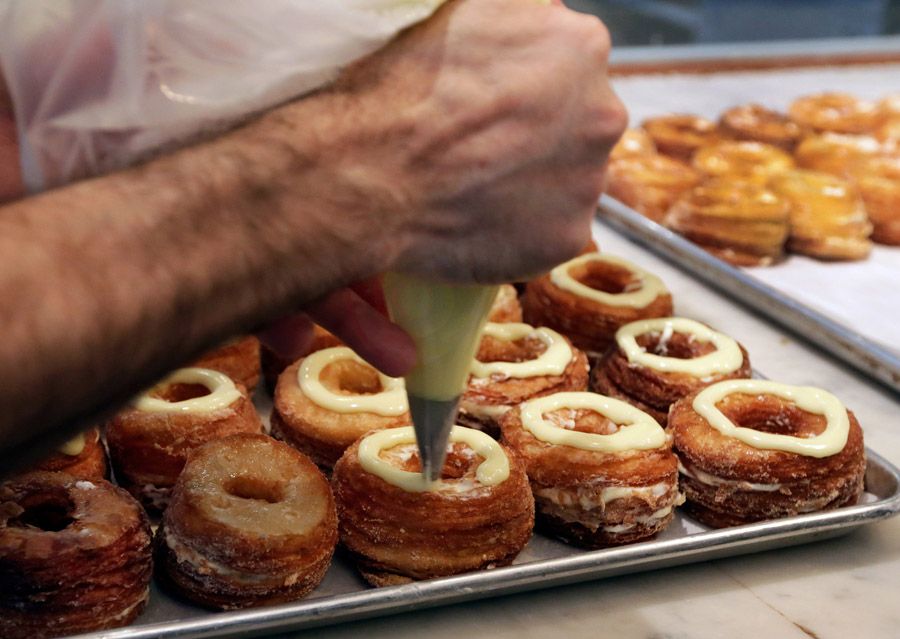 Chef Dominique Ansel makes Cronuts, croissant-donut hybrids, at his bakery in New York. — Photo: Richard Drew/Associated Press.NOT EVEN a frigid winter storm could deter some New Yorkers from their beloved Cronuts on Friday morning. Chef Dominique Ansel makes Cronuts, croissant-donut hybrids, at his bakery in New York. — Photo: Richard Drew/Associated Press.NOT EVEN a frigid winter storm could deter some New Yorkers from their beloved Cronuts on Friday morning.
Over 100 people braved below-freezing temperatures to line up outside Dominique Ansel Bakery, home to the popular pastry, as early as 6:30 a.m.
“We received quite a few emails the night before confirming we were going to be opened the morning after the storm because they were going to come — rain or shine,” chef, owner and Cronut creator Dominique Ansel told the Los Angeles Times in an email.
The shop, which opens at 8 a.m. Monday through Saturday and 9 a.m. Sunday, is used to such Cronut mania. The pastry, named one of Time magazine's 25 best inventions of 2013, made its debut at the bakery in May. Since then, versions of the croissant-doughnut hybrid have been in stores all over the world.
Jeremy Gan, a 23-year-old graduate student at New York University, was near the front of the line with his brother, with just two people ahead of them.
Gan had never tried the Cronut before. His reaction?
"It perfectly represented the distinct sweet sugary flavor of the doughnut, yet preserves the [flakiness] of the croissant," he said.
For Vivian Leba, 26, it is tradition to visit the shop with her friend, whom she jokingly nicknamed “Cronut Girl”, because of her passion for the pastry, whenever they are in town from Houston.
“The cold is merely an insignificant obstacle regarding our fortitude for Cronuts,” Leba, who is a photographer, told the Los Angeles Times. “When you have a mutual love for food, it's very much about the camaraderie you share with everyone who's in line for the same thing — pastry divinity.”
Leba said when she and her friend arrived at 8:15 a.m., there were about 40 people in line ahead of them and 30 people behind them. This is what Leba considers a short wait for the Cronut.
To make the long line easier in the chill, Ansel said the store provided complimentary hot chocolate, madeleines and hand warmers.
“We really appreciate the folks who show and support creativity and our little pastry,” he said.
Even with the winter weather, Ansel didn’t seem surprised by the long lines.
“It's a very passionate crowd, and on a daily basis I've always found they all have their reasons,” he said. “For some of them, it's a New Year's resolution. For others, it's a birthday gift for someone they really care about. Still others — it's about that only-in-New-York experience.”www.latimes.com/nation/nationnow/la-na-nn-cronut-line-storm-new-york-020140103,0,2423614.story
|
|
|
|
Cronuts
Apr 16, 2016 20:32:57 GMT 10
Post by KTJ on Apr 16, 2016 20:32:57 GMT 10
from The Washington Post....One of these is the Cronut. The other is food plagiarism.
And you can't stop it.By LAVANYA RAMANATHAN | 8:00AM EDT - Friday, April 15, 2016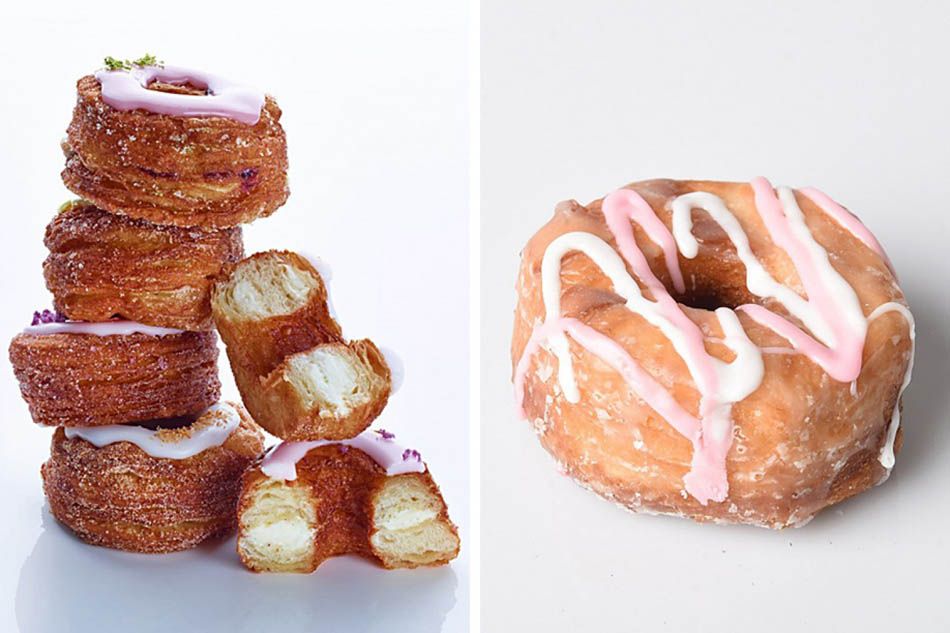 LEFT: Dominique Ansel Bakery's Cronut, a pastry that melds a croissant and a doughnut, debuted in 2013 and is available only at Ansel's SoHo bakery. LEFT: Dominique Ansel Bakery's Cronut, a pastry that melds a croissant and a doughnut, debuted in 2013 and is available only at Ansel's SoHo bakery.
RIGHT: The Croissant Doughnut from Dunkin' Donuts was introduced a year later, and aims to capitalize on foodies' desire to try the real thing.
— Photographs: Left, Thomas Schauer; right, Matt McClain/The Washington Post.TO taste a Cronut — an actual, legit Cronut — you must be willing to brave the sea of humanity that amasses each morning outside Dominique Ansel Bakery in Manhattan.
You can also go to a Dunkin' Donuts in pretty much any city and order something that's kind of like Ansel's iconic pastry, cut from croissant dough and then deep fried. Or, in Sacramento, you could have a Doissant. In San Francisco, you can scarf down a Cruffin, which is not a doughnut at all, but hey, close enough.
Given how fast food trends emerge and travel, it's not surprising that there's a Cronut, or Faux-nuts.
But the hottest food trend of the past five years may be copycatting.
Call it food plagiarism.
And the examples go way beyond the Cronut.
Kimchi quesadillas and short-rib tacos were the brilliant pairings that launched Los Angeles's Roy Choi and the Kogi food trucks — and then set off an echo-boom of Korean-taco knockoffs. New York's Doughnut Plant claims to have cooked up square jelly doughnuts nearly a decade ago; but now you can have one at Washington's Astro Doughnuts. Do you drool over the over-the-top cakes with ganache drippings that Australian home baker Katherine Sabbath posts for her nearly 300,000 Instagram followers? Buzz Bakery can sell you an “homage”, and so can plenty of other shops from New York to California.
And for a doughy bun overstuffed with a slab of fatty pork belly and a schmear of hoisin, you can head to one of the restaurants in David Chang's growing Momokiss meu empire, or any of the quintillion American ramen shops made in Momokiss meu’s image.
“Once upon a time, a chef produced something, and it slowly made its way around, by people eating there, by word-of-mouth, by traditional media,” says David Sax, author of “The Tastemakers”, which traces the evolution of food crazes. This is how it worked in the days of the Caesar salad and the baked Alaska.
But if cooking has always revolved around adapting and perfecting existing dishes, why does this feel different?
One word: speed. “It's happening so quickly, it's impossible to control,” says Sax.
Point a pastry-cream-covered finger at Instagram, which provides the blueprints for bakers in Ohio and Jakarta to start food-coloring perfectly good bagels the unholy hues of a Grateful Dead T-shirt. And don't forget the foodies, eager and willing to gobble up the edible equivalent of a fake Fendi bag.
But unlike the purses of Canal Street, food copycats may even affirm the value of the real deals and turn an unknown chef who spawns a trend into a household name.
If no one copies your pork bun or your rainbow bagel, “if nobody cared enough to even imitate it,” says Sax, that means “it doesn't resonate with anyone.” Washington's Takorean makes Korean tacos, including this one with caramelized tofu and spiced kale with lime crema. Washington's Takorean makes Korean tacos, including this one with caramelized tofu and spiced kale with lime crema.
— Photograph: Kate Patterson. Little Sesame, a new Washington hummus shop, offers a bowl topped with beets, hazelnuts and herbs that’s similar to a dish Little Sesame, a new Washington hummus shop, offers a bowl topped with beets, hazelnuts and herbs that’s similar to a dish
served at Philadelphia’s Dizengoff. — Photograph: Lavanya Ramanathan/The Washington Post.Copyright vs. copycatsJames Beard Award-winning chef Mike Solomonov and his business partner, Steven Cook, have opened several popular Philadelphia eateries: Israeli restaurant Zahav; a hummus place known as Dizengoff; and a Korean-chicken-and-doughnuts joint called Federal Donuts. And his fans, he says, email him when they spot what look like plagiarists.
Dizengoff serves a hummus bowl with beets and hazelnuts, and in Washington, hummus restaurant Little Sesame serves a hummus bowl with beets and hazelnuts. Phoenix's Welcome Chicken + Doughnuts looks a lot like Federal Donuts.
“It's sometimes a little bit weird,” Solomonov confesses. “You're, like, ‘Wow, they’re doing Korean fried chicken and doughnuts?’ Wouldn't they want to do something different?”
But he's learned to shrug it off. “We didn't invent Korean fried chicken, and we didn't invent cake doughnuts,” he says.
In fact, he's convinced that somewhere in Israel, a chef is looking at his restaurants and yelling, “What the $*#)?”
“We all copy each other anyway,” he says. “Especially when you're young and inexperienced — you do what you know is going to make people happy.”
Sometimes, however, the plagiarist isn't a naive young chef. Burger King boldly hawks the Big King, which is exactly what it sounds like: an uncanny match, double patty for double patty, sesame-seed bun for sesame-seed bun, for McDonald's Big Mac. Another burger chain, Red Robin, has begun serving a towering new sammy that unabashedly apes New York chef Keizo Shimamoto's behemoth trend food, the Ramen Burger.
In March, frozen-yogurt chain 16 Handles unveiled MMMilk & Cereal, a cornflakes-flavored treat that chief executive Solomon Choi proudly declared “you won't see anywhere else.”
But we have: At Milk Bar dessert shops, where Christina Tosi's Cereal Milk soft-serve has been one of the most iconic sugar rushes of the past decade.
“MMMilk & Cereal” was hastily renamed “Cereal Bowl”, but it remained on 16 Handles' taps.
How is that possible?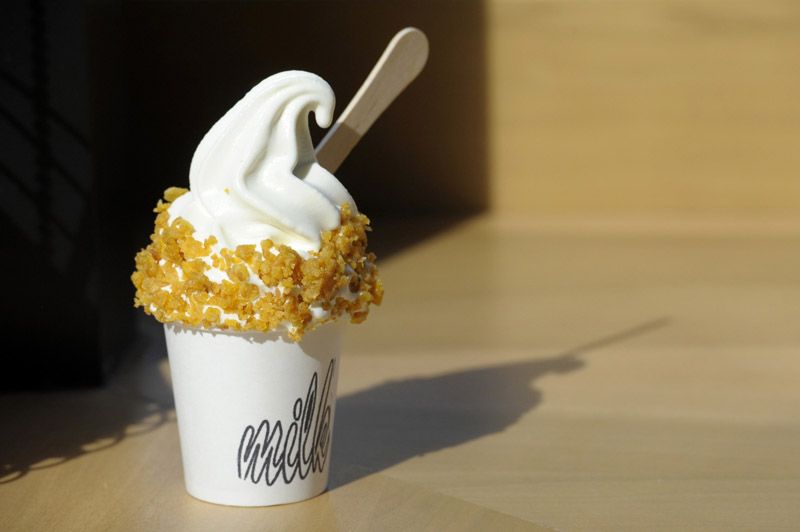 Cereal Milk has been a staple soft-serve flavor at Christina Tosi's Milk Bar for years. Last month, frozen-yogurt chain 16 Handles Cereal Milk has been a staple soft-serve flavor at Christina Tosi's Milk Bar for years. Last month, frozen-yogurt chain 16 Handles
unveiled a flavor it called MMMilk & Cereal. — Photograph: Katherine Frey/The Washington Post.Chefs can protect the names of their unique creations — think Boardwalk Fries, the Cronut or Coca-Cola — says Michael F. Snyder, a Philadelphia lawyer experienced in food industry intellectual property law. It's far harder, he says, to prove that someone's dish is a knockoff, mostly because it's a high bar to prove that yours is original.
What about a recipe? Forget it. In the eyes of the U.S. Copyright Office (and the courts), recipes are just lists of ingredients that can't be copyrighted; neither can a chef copyright a work derived from something that already existed. And what chef can argue that they've created not only a new dish, but also the cooking techniques that went into it?
Designs, like the ridges in a Ruffles potato chip, can be copyrighted if they're unique, Snyder says, but once a chef cooks a dish on a television show or publishes a cookbook, a business secret becomes fair game.
Even so, Ansel published a version of his Cronut recipe for home cooks. “I don't think worrying about imitators is a healthy way to create,” he says by email. “Protecting yourself and your intellectual property is something I've had to learn to do.” Ansel trademarked the Cronut name, but not for the reasons you might expect. He was prompted, he says, by “trademark trolls, who sweep in and trademark something they didn't create and later prevent the creators from using the name.”
And he doesn't think that plagiarism is just part of the business. “Quite the opposite, actually,” he says. “I think the nature of the business is for chefs to create and express their own styles.”Who started it?For eons, dining has evolved as ideas are built upon ideas. A new dish tweaking some stale old dish emerges. Chefs also pass on techniques to their underlings.
“Plenty of people know how to make our hummus,” Solomonov says of his former chefs. “There are no secrets.” A restaurant's real intellectual property, he argues, are the intangibles: service, consistency, mood and ambience. “It isn't the recipes at all.”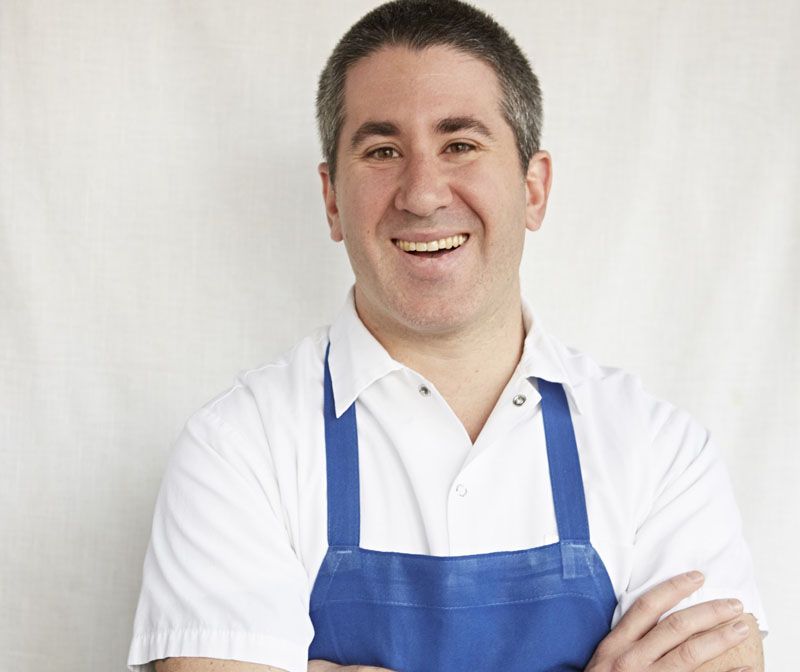 Philadelphia chef Mike Solomonov says that fans write him when they see knockoffs of his dishes around the country. Philadelphia chef Mike Solomonov says that fans write him when they see knockoffs of his dishes around the country.
— Photograph: Mike Persico.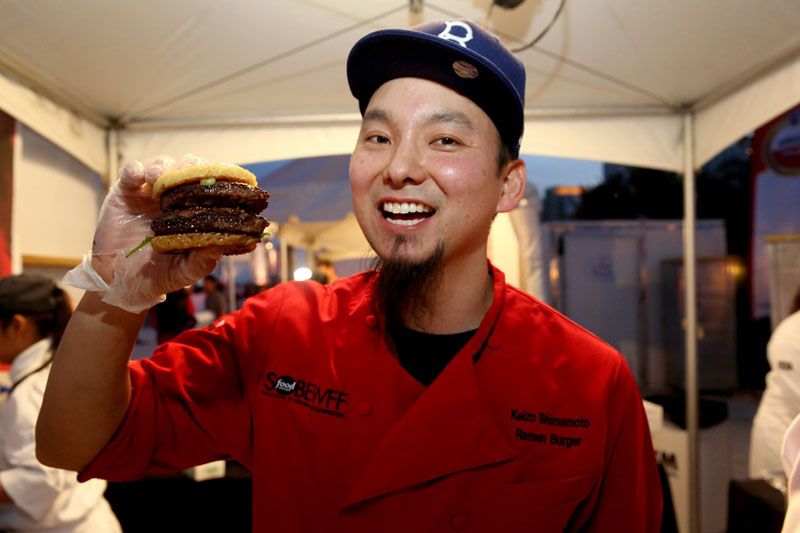 Chef Keizo Shimamoto created the Ramen Burger, modeled after Japanese street food and the fare at In-N-Out Burger. Now, Chef Keizo Shimamoto created the Ramen Burger, modeled after Japanese street food and the fare at In-N-Out Burger. Now,
chain Red Robin offers a version. — Photograph: Aaron Davidson/Getty Images/Food Network SoBe Wine & Food Festival.Perhaps this is why chefs rarely call one another out publicly for food plagiarism but do frequently accuse each other of stealing a concept, a name or a restaurant's look. Often, they do it in a good old-fashioned legal filing, says Snyder.
In one of the most memorable cases, the U.S. Supreme Court weighed in on whether one Texas fast-food chain, Two Pesos, had mimicked the appearance of another, Taco Cabana. It awarded millions to Taco Cabana.
In New York, the Kati Roll Company sued in 2014 when a competitor opened with a similar name and common colors in its logos and interior design, not to mention dishes that smacked of food plagiarism.
The rival's response? If the food was similar, wasn't it because both restaurants served traditional Indian food, which is thousands of years old?
The other restaurant eventually changed its name, but it had a point.
Who can lay claim to dishes that seem to have appeared out of nowhere and spread like wildfire? Who knows who fried the first batch of crispy Brussels sprouts, or who first eyed a flavorless iceberg-lettuce salad and decided to use kale instead?
It's an “industry where no idea is truly original,” says Sax, although these days, chefs do “take credit for stuff. They Instagram it, and they hashtag it. That's the currency by which they're building their brand.”
David Chang, he says, didn't create ramen. “Dominque Ansel did not invent doughnuts or croissants, or even some cream-stuffed proofed dough pastry.”
Of their copycats, Sax says, “while it may seem like intellectual thievery and rip-offs, fundamentally, this is how the culture of food moves forward.”
“If a chef puts something on their menu that they weren't the first to do, that's not a crime. That's cuisine.”• Lavanya Ramanathan is a features reporter for Style at The Washington Post.www.washingtonpost.com/lifestyle/one-of-these-is-the-cronut-the-other-is-food-plagiarism-and-you-cant-stop-it/2016/04/15/2f0bda36-ef7e-11e5-85a6-2132cf446d0a_story.html
|
|
|
|
Cronuts
Apr 16, 2016 20:36:39 GMT 10
Post by KTJ on Apr 16, 2016 20:36:39 GMT 10
The Claireville Bakery was knocking out Cronuts that looked exactly the same as the originals (they even called them Cronuts) from about three years ago until early this year, then they suddenly disappeared from their menu. I wonder if they got a lawyer's letter on behalf of Dominique Ansel Bakery?
|
|
Deleted
Deleted Member
Posts: 0
|
Post by Deleted on Apr 17, 2016 6:50:06 GMT 10
The Claireville Bakery was knocking out Cronuts that looked exactly the same as the originals (they even called them Cronuts) from about three years ago until early this year, then they suddenly disappeared from their menu. I wonder if they got a lawyer's letter on behalf of Dominique Ansel Bakery? Maybe they should have named them 'doughssants' ?  |
|
|
|
Cronuts
Apr 17, 2016 9:28:43 GMT 10
Post by KTJ on Apr 17, 2016 9:28:43 GMT 10
I tried them on two separate occasions a couple of years ago.
They were dangerously nice, but I dread to even imagine the huge number of calories in each cronut.
So I've never touched them since....they would definitely be bad for your health.
|
|








